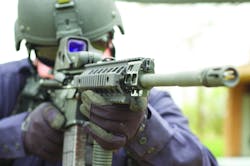Many agencies who have received M16A1's, via the DRMS 1033 program, have wanted to upgrade these rifles to carbine configuration and to get away from the 1/12 twist rate to better address the needs of their agencies. Many have purchased upper receivers and collapsible stocks from various companies to obtain this goal. Now SIG Sauer is offering their version of the AR, the 516, as an upper receiver assembly upgrade kit for your existing rifles.
In 2010, my department hosted the SIG Sauer Armorer class. During the class we got a heads up that SIG was going to debut a new rifle at the SHOT Show the following week. I was there and had a chance to examine the new 516 and 517 piston operated AR15/AR10 based rifles. I was impressed with some of the design features, but it seemed that everyone but me was jumping on the piston operated AR bandwagon.
Fast forward to January 2011. I received information from SIG that they were offering the 516 upper receiver as a kit. I knew that Ruger was going to do the same with their SR-556 but SIG uses 1/7 and the Ruger uses 1/9 twist rates and I was more interested in the SIG offering. The idea of upper receiver kits has come up from time to time in both the law enforcement context, as I stated above, and also in the civilian shooting world. In California, many of my shooting buddies have registered AR lower receivers that they wanted to upgrade in various ways. Some are into piston systems and have been following the development of various systems with the hopes of retrofitting their rifles. With this in mind I contacted SIG and asked if they could send me one of the 516 kits for a review.
The SIG 516 kit that I received came in a full size SIG Sauer rifle case. The case contained the complete upper receiver, owner's manual, replacement recoil spring and buffer. I noted that it has a forged 7075-T6 aluminum flat-top upper receiver with traditional forward assist, shell deflector and dust cover that mates directly with the top rail of the forearm. The forearm is an aluminum free floated SIG Sauer brand with Picatinny rails on all four sides. It has a 1/7 twist 16' chrome lined barrel with SIG's take on a modified M4 contour. The upper receiver has a nice, smooth, black finish. The quad rail forearm was attached solidly and indexed to the upper receiver via a protrusion in the rail that fits inside of a cut out notch in the top of the receiver is a kind of tongue and groove arrangement. I liked this feature as it keeps the rail in proper rotational alignment with the upper. The finish on the rail was more of a gray than the upper and had a rougher texture. Two female non-anti-rotation sling sockets are machined into the left and right side of the rail at the front and rear. The gas block is dark black and shinier than the receiver and unfortunately showed machining marks on both sides. The gas block had a bayonet lug machined into the bottom of it with a short section of Picatinny rail machined into the top for attaching backup iron sights or anything else you want to attach.
A three-position gas regulator is housed in the gas block and protrudes out the front for easy access for adjustment and disassembly. The regulator is threaded into the gas block and held in position by a captured spring-loaded plunger. This plunger has to be pressed down to allow the regulator to be unscrewed for cleaning. It has a square shaped forward section that protrudes forward with a hole in the middle. By grasping this square section and rotating the regulator, the operator can select between various gas settings. The hole is for inserting a tool or a 5.56mm round into just in case you cannot rotate it by hand. The standard three position regulator can be adjusted to the following settings: the standard position allows enough gas into the system to operate the rifle under normal conditions, an adverse position allows more gas into the system for when the weapon is fouled or other conditions such as temperature are interfering with reliable function of the rifle, and a final setting for use with suppressors that reduces the amount of gas into the system. A four position regulator is available from SIG that adds a setting that cuts off all of the gas into the system. This setting has uses for customers with specific needs such as the use of certain rifle grenades. The unit I was sent came with the four position regulator.
The bolt carrier is consistent with other designs used in piston operated ARs. It has a "tombstone" like piston contact lug in place of a traditional gas key that does not protrude over the bolt cam pin. The rear of the bolt carrier is fluted and rounded, both aiding in reliable function. I was surprised to see that the bolt was a standard AR bolt complete with gas rings. I like the fact that the bolt is not a proprietary part as bolts are known to break. A shelf on the front of the bolt carrier indexes with a standard AR charging handle to allow the bolt and carrier to be cycled like any other AR.
The push-rod gas system is a short stroke design set to standard AR carbine gas tube length. The idea behind a piston system is to isolate fouling and heat in the forward gas block area and out of the action. The idea being that a piston system is more reliable in severe conditions and operates cleaner. Excess gas is vented out of the front portion of the handguard to the rear of the gas block via vent holes in the piston rod. The system has been called self-cleaning but do not let that confuse you. Fouling is still deposited in this area and it needs to be cleaned just like any other rifle. You can dissemble the gas system by unscrewing the regulator from the gas block and pulling out the one piece corrosion resistant coated piston rod without field stripping the rest of the rifle. The return spring assembly comes out with the piston rod. The end of the gas piston impacts against the lug on the bolt carrier. During firing gasses are vented into the gas block, forcing the piston rearward against the lug on the bolt carrier, cycling the rifle.
The kit did not come with any sights. Fortunately I had a Laser Devices EOLAD in for testing and installed it on this upper. I tossed on an old vertical for grip and grabbed an extra lower I had to put the rifle together. I took the rifle out to the range several times. The first was on a cold and rainy day. I inserted a magazine and pressed the bolt release. The first round did not chamber fully. I cleared the round and never had a single hiccup after that. Once sighted in, I was able to produce some great groups from the bench and off-hand. I fired an assortment of ammo through this upper including some old surplus ammo from the 80's all the way up to some fresh 75 gr. Hornady TAP. It fed and functioned with everything I threw at it. Unfortunately I did not have any steal cased Wolf to toss in it during this test.
Shooting the 516 upper I noticed that it was not at all as front heavy as other piston AR systems I have shot over past couple of years. Recoil was smooth but was noticeably more pronounced during rapid fire. My groups from 25 yard hammers were further apart than what I usually produced. This may be inherent with some piston systems and not something unique to the 516. I could see the excess gas being vented out the front but this did not create any issues. Overall the upper was accurate, reliable, and a pleasure to shoot.
Cleaning the rifle afterword was a snap. The piston and regulator contained most of the fouling but cleaned up easily. The amount of fouling on the bolt and bolt carrier was much less that what I usually see in a direct gas system AR. None of this was a surprise as this is one of the selling points for any piston system. At this point I did not see any indications of damage to the lower or stock extension caused by bolt tilt which has proven to be problematic with some piston AR's. Only time will tell with the 516.
I did notice that the fit between the upper and lower was loose and the upper wobbled on some of the lower receivers that I installed the 516 upper on. This did not affect function but can cause issues with accuracy. I installed an Accu-Wedge on the lowers that did not match up tight and this solved the issue.
SIG is offering the 516 upper receiver kits in several barrel lengths to meet the needs of individuals and agencies. This kit is a quick and easy way to convert your existing rifle to take advantage of a carbine length short-stroke piston system.
About the Author

Dennis Haworth
Dennis Haworth is a police officer with a California state law enforcement agency. He has been a law enforcement range master and armorer for over a decade. He has served as a police academy instructor and has taught specialized courses on several subject matters. He has been involved in product testing for professional associations, manufacturers and law enforcement agencies. He has a BS in Criminology and an MPA with a specialization in human resources management. Much of his free time is spent as an advisor to the Shooting Sports Club at his local University of California campus.
